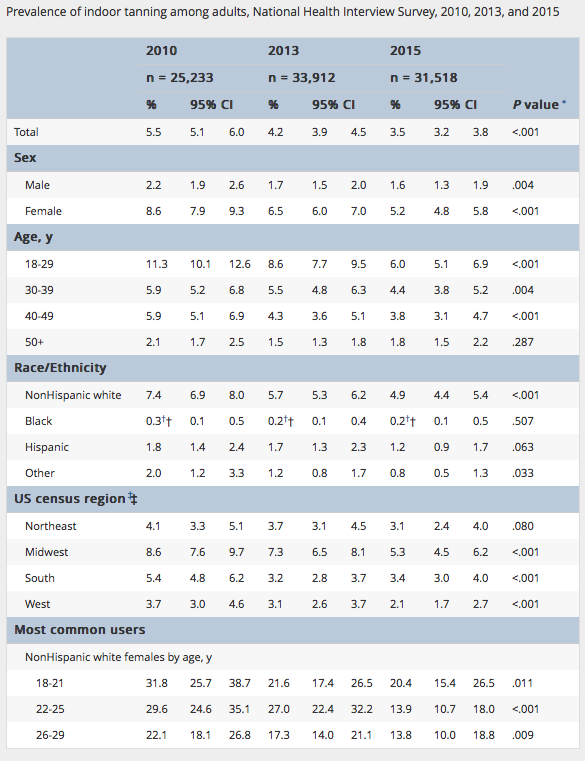It seems like the important message about the dangerous effects of indoor tanning is getting through.
Between the years 2010 and 2015, there's been a significant decrease in the number of American adults who use tanning beds, according to results of a recent study. By analyzing voluminous survey data, researchers concluded that use dropped 33 percent during that five-year period.
In 2010, 11.7 million adults of both sexes in the United States declared that they used tanning bed, but in 2015 that figure dropped to 7.8 million – a noticeable and welcome difference. Put another way, over that span the percentage of all adults in the survey reporting use of these devices fell from 5.5 to 3.5. (see first line on below table, courtesy study's authors Gery Guy, PhD, et al)
Better still, even the demographic group most drawn to indoor tanning – young, non-Hispanic white women – reported 30 percent less usage.
“It is encouraging that evidence is emerging of reduced exposure to indoor tanning. However, as this practice incurs absolutely no benefit in the face of increased risk of a potentially lethal disease, continued efforts to further reduce exposure is important,” stated Yale University's Michael Bracken, as reported by Reuters, who was not involved in the research.
The study, "Trends in indoor tanning and its association with sunburn among US adults," was published in the Journal of the American Academy of Dermatology.
 Researchers studied survey responses from 25 million adults who, according to the authors, participated in the "2010, 2013, and 2015 National Health Interview Survey (NHIS), a nationally representative sample of the US civilian noninstitutionalized population aged ≥18 years. Respondents were asked about indoor tanning and sunburns (from the sun or indoor tanning) during the preceding 12 months."
Researchers studied survey responses from 25 million adults who, according to the authors, participated in the "2010, 2013, and 2015 National Health Interview Survey (NHIS), a nationally representative sample of the US civilian noninstitutionalized population aged ≥18 years. Respondents were asked about indoor tanning and sunburns (from the sun or indoor tanning) during the preceding 12 months."
As we have written in the past, "doctors have repeatedly warned against sun exposure, as well as both outdoor and indoor tanning," and it was only just over a year ago that we highlighted "a report in JAMA Dermatology linking the risk of melanoma with indoor tanning. The link was particularly strong for women who had (1) begun tanning at younger ages, and (2) had more frequent tanning sessions."
While there's much to embrace in this study, it doesn't come without some possible limitations. One is that the nature of surveys presents possibilities that data can be misreported, however a mitigating factor is that the sample size is extremely large.
Finally, we could not agree more with the authors, who, looking forward, wrote that since there's "continued use among young women and the availability of indoor tanning ... [r]educing indoor tanning remains an important opportunity for the primary prevention of skin cancer."




